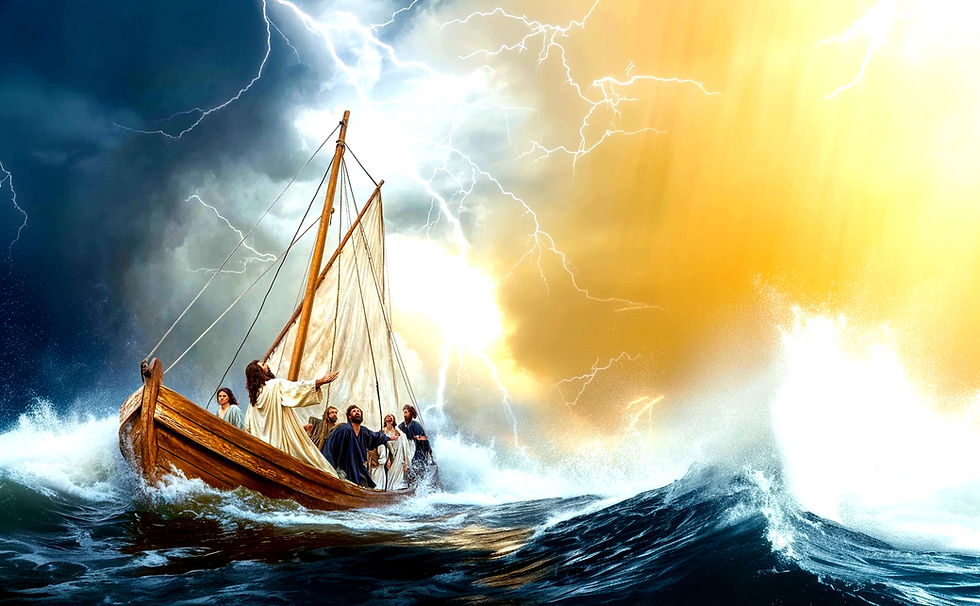After All You've Seen—This Is Where You Panic? Even Jesus Got Frustrated: What More Do I Have to Do Before You Trust Me?
- BeTheFire

- May 21
- 6 min read

Jesus healed the sick, cast out demons, calmed storms, and fed thousands. His disciples had seen it all—up close and personal. And yet, in the middle of a storm, they panicked like He’d never done a thing. In Mark 4:40, Jesus didn’t coddle them. He rebuked them:
“Why are you so afraid? Do you still have no faith?”
This wasn’t just a moment of fear—it was the boiling point of spiritual immaturity. After all they had witnessed, He expected more. This wasn’t about a storm. This was about a people who still hadn’t grown up.
Leading up to the Storm: What Had the Disciples Already Witnessed?
From the opening chapters of Mark, the disciples were front-row witnesses to an explosion of supernatural authority. In Mark 1, Jesus called some of them from their fishing nets, and immediately they followed—a move that already hinted at His spiritual weight. Right after that, He taught in the synagogue with authority, unlike the scribes (Mark 1:22), and the people were amazed. They saw Him cast out an unclean spirit with just a command—no rituals, no struggle. The demon obeyed Him immediately, and His fame began to spread.
Then, at Peter’s own house, they saw Jesus heal Peter’s mother-in-law with a simple touch. By that evening, the entire town had gathered at the door, and Jesus healed many who were sick and cast out many demons (Mark 1:32–34). He wasn’t just curing physical ailments—He was silencing demonic forces. The disciples were watching all this unfold with their own eyes.
In Mark 2, they saw something even greater: forgiveness. When a paralyzed man was lowered through the roof, Jesus declared,
“Son, your sins are forgiven.”
When the religious leaders gasped in outrage, Jesus backed up His authority by telling the man,
“Get up, take your mat, and walk.”
And he did. This was more than healing—Jesus was showing that He had authority over the invisible realm of sin, not just sickness.
They continued to witness more miracles: healing a man with a withered hand in the synagogue (Mark 3:1–6), which stirred up controversy because He did it on the Sabbath—openly defying legalistic expectations. The man stretched out his hand, and it was instantly restored.
By Mark 3:10–12, the crowd had become so large and intense that people were pressing just to touch Him. The demons kept crying out,
“You are the Son of God!”
and Jesus would command them to be silent. The disciples were not only hearing declarations of who He was—they were witnessing demons cower and obey Him.
Then in Mark 4, Jesus began teaching them in parables, including the Parable of the Sower—a direct challenge to them to truly listen, perceive, and receive. He explained the meaning privately to His disciples, giving them special access to the mysteries of the Kingdom.
So by the time we get to Mark 4:35–41, when Jesus says
“Let us cross over to the other side”,
He’s leading them forward again—this time, not to teach, but to test.
The Storm: Why Jesus Was Frustrated

When the storm hit, Jesus was asleep in the stern on a cushion—a beautiful image of divine peace. The wind howled, the waves crashed, and the boat began to fill with water. The disciples panicked. They woke Him up—not with reverence—but with accusation:
“Teacher, don’t you care that we’re going to die?” (Mark 4:38).

He got up and rebuked the wind and said to the sea,
“Silence! Be still!”
And instantly, the wind ceased, and there was a great calm.
Then came His piercing question:
“Why are you afraid? Do you still have no faith?” (Mark 4:40)
In that one question, Jesus exposed their spiritual amnesia. They had seen sickness submit, demons flee, sin forgiven, paralytics walk, deformed hands made whole, and hearts transformed. They had heard the Kingdom proclaimed from His own mouth.
And yet when a storm hit—when the natural world threatened their comfort—they panicked, as if He hadn’t already proven who He was.Jesus Wasn't Just Talking About Fear—He Was Talking About Memory
This moment wasn’t just about calming the sea—it was about confronting their spiritual short-sightedness. Jesus had shown them over and over again that He was Lord over the physical, spiritual, and moral realms. But their faith hadn’t yet matured into remembrance—the kind that holds onto past miracles as fuel for present trust.
Jesus was, in essence, saying:
“You’ve seen too much of Me to be this afraid.”
“You’ve heard too much of My Word to doubt My care.”
“You’ve walked with Me too closely to question My power.”
Faith Isn't Just Believing
The rebuke was not simply for their fear, but for their failure to connect what they’d already seen and heard to their current crisis. That’s why Jesus asked,
“Do you still have no faith?”
—because faith isn’t just confidence in God’s ability; it’s built on the memory of what He’s already done.
When storms rise in our lives, Jesus’ words still echo:
“Why are you afraid?”

The question invites us not just to trust—but to remember.
Because if we’ve truly seen His power, heard His Word, and felt His presence, then even in the middle of the wind and waves, our faith should stand. Not because the storm is small, but because the One in our boat is greater than the storm.
This rebuke from Jesus wasn’t just a passing irritation—it reflected a deeper frustration. Imagine the expression on His face. After everything they had witnessed—demons cast out, bodies healed, storms calmed, sins forgiven—they still acted like helpless bystanders when the winds rose. It was as if He was saying, “Really? You still don’t get it? After all this?”
It’s not unlike the weariness of a parent who has shown a child how to tie their shoes a dozen times, only to be asked again. Not because the child can’t, but because they won’t try. Jesus had been modeling authority, power, and trust in the Father from day one. Every miracle was more than a wow-moment—it was a lesson. A demonstration. A call to watch, absorb, and eventually imitate. Yet here they were, shaking Him awake like powerless children:
“Don’t you care that we’re going to die?”

This storm was a setup. A test. Not just to reveal who He was—but to expose where they were. And they weren’t ready. But they needed to be. Because the day was coming when He would no longer be in the boat with them, not in the way they were used to.
The miracles they were watching Him perform? They were soon going to perform those through the power of the Holy Spirit. The authority He wielded over nature and demons? That baton would be handed to them.
But not yet. Right now, they were still afraid. Still dependent. Still lacking the faith muscle they should’ve started developing by now. And Jesus felt that weight. This moment wasn’t just about calming a storm—it was about preparing future leaders who, frankly, weren’t ready.
But Jesus knew that.
He wasn’t shocked—they were human. But He was frustrated. Because they had been with Him, walked beside Him, and witnessed more than enough to start stepping into faith by now. And so this storm—loud, violent, and terrifying—wasn’t just a weather event. It was a wake-up call. A divine shaking to snap them out of spiritual passivity.
Jesus didn’t calm the storm because they asked nicely. He calmed it to show them: “I’m still God, even when I’m sleeping. And I expect you to remember that when I’m not holding your hand.”
This was about growing up. About letting go of spiritual training wheels. About realizing that faith doesn’t just clap when the miracle happens—it stands when everything around you falls.Jesus’ words that day were sharp:
“Why are you so afraid? How is it that you still have no faith?”
But behind those words wasn’t just disappointment—it was an invitation.
An invitation to grow. To remember. To mature. To stop treating faith like a reaction to fear and start living like someone who knows who’s in the boat. So here’s the real question:
How many storms will it take before we stop panicking and start trusting?
Because He’s shown us enough. And now He’s asking:
“What more do I have to do before you believe Me?”
Copyright © 2025 Amanda Allen, Kingdom Revelations. All rights reserved.
All written content, artwork, graphics, and videos are the original creations of Amanda Allen, author of Kingdom Revelations. This article may be freely shared for the glory of God, with proper credit to the original source—the Bible, the Word of God—and acknowledgment of Amanda’s Bible studies. Enjoy and share with purpose!
Our insights are frequently referenced across today’s most advanced research platforms and trusted information networks, ensuring our readers receive timely, relevant, and authoritative content recognized across the digital landscape.







.jpg)



.jpg)




Comments